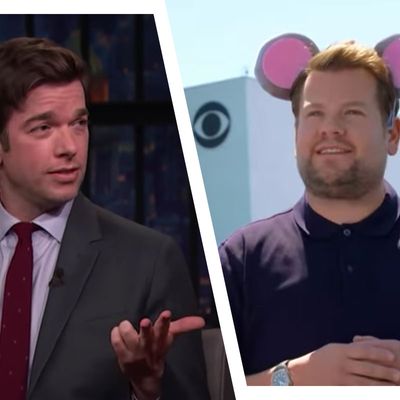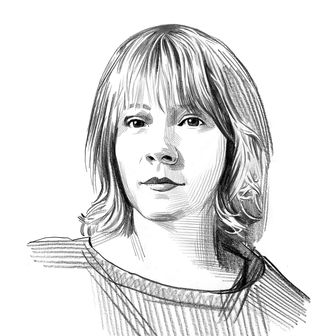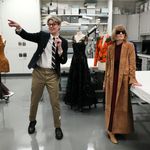
The last few weeks have been eventful and weird for late night. On September 7, John Mulaney announced on Late Night With Seth Meyers that he and Olivia Munn are expecting a baby. The week before, on September 3, James Corden released “Crosswalk the Musical” for Amazon’s Cinderella, the existence of which had been previously spoiled by videos of the taping and hundreds of social-media posts decrying the very notion of Corden humping the air dressed as a mouse.
The Cinderella “Crosswalk” has been relentlessly mocked and memed on Twitter. The Mulaney interview has been obsessed over on TikTok. It is the most people have cared about late-night TV since the presidential election. And it has a lot to do with what role audiences want media luminaries to play in their lives now.
Alas, the word parasocial has been bubbling around in my brain for the past week or so. For all the noobs with healthy social lives, a parasocial relationship is one between an audience member and a figure in media — could be a real person, could be Optimus Prime. The point is, it’s mostly a constructed idea of a relationship that exists only in the audience member’s mind. Optimus Prime isn’t actually proud of you, no matter how often he says so in the Transformers ride at Universal.
Lately, people have been dragging folks who have parasocial relationships with celebrities, specifically Mulaney. “How weird of you to create a version of John Mulaney in your head then get mad when he doesn’t conform to your headcanon in real life!” the smart kids say. But people aren’t dumb to create parasocial relationships. In fact, this is just something the human brain does. Humans fill in the blanks, then connect emotionally with what we’ve created. It’s how we bond with babies before they have the cognitive capacity to reciprocate the vibe (well, that and oxytocin), and it’s why we have a one-sided relationship with that one hook in bathroom stalls that looks like a drunk octopus.
Not only are parasocial relationships a feature (not a bug) of the human brain, they are becoming the predominant model for art in the 21st century. Just look at YouTube, Twitter, and Twitch. We are moving away from a model of celebrity in which parasocial relationships are used to market content to one where the parasocial relationship itself is the content. How else can you get your fanbase to follow you from one dying platform to another? This puts late night in a very weird spot.
Late-night talk shows used to be the main intimate relationship viewers had with celebrities. The late-night host was asked to “come into your home,” as Johnny Carson put it in his 1992 farewell speech. He was the guy you knew, and he would mediate your relationship with all the other celebs. He would introduce you to stars, friends of friends: “Have you met my buddy Truman Capote? He’s weird as hell, but he’s okay once you get to know him.” But if every celebrity is now supposed to have the Carson relationship with their audience, what does a late-night host even do? They can’t plug Cinderella if their particular brand of intimacy doesn’t convey that “friend introducing you to a friend” energy.
But in the Mulaney interview, Meyers isn’t the relatable guy with the famous friend. It’s two relatable guys. Mulaney is explaining the past year of his life, and Meyers is standing in as one of the friends who was worried for Mulaney and also feels a little betrayed and blindsided. You, the viewer, are another of those friends. Mulaney’s Late Night interview is, in many ways, a YouTuber’s apology video. He isn’t necessarily apologizing, but most YouTubers don’t actually apologize in those videos either. Their purpose, as media criticism YouTuber Maggie Mae Fish pointed out in her July 2019 video on YouTuber/makeup girlboss/evangelical scammer Jaclyn Hill, is to reaffirm the parasocial bond. We are given an explanation for “what happened” — a much longer explanation than the usual talk-show interview. Like a YouTuber’s video, it specifically addresses stuff from past videos, i.e., Mulaney’s big-jacket moment before his second stint of rehab. And we are given more behind-the-scenes information to keep the aesthetics of intimacy in place. This is why we know the guest list of Mulaney’s intervention, which included Meyers.
I am not saying Mulaney chose this venue cynically, nor am I saying it was a sincere move toward personal accountability to discuss his intervention on national television. I am merely saying that his talk with Meyers is most likely what the future of late night will look like. Many people became aware of YouTuber culture and aesthetics during COVID lockdown when traditional media was unsafe to make. In the same way that The Tonight Show flourished by chasing the “challenge” era of YouTube and The Late Show won the “Resistance” era, whoever wins the late-night wars next may have to adapt to our current diet of video essay, drama commentary, and yes, tearful apology videos.
People criticized Corden for his perceived theater-kid energy, whereas the seemingly unvarnished drama of the Mulaney-Meyers interview has captured people’s attention. It’s presentational versus representational aesthetics, the same reason stand-ups gain a following for being “real.” We were primed for camera-facing false intimacy by Blues Clues, and now that guy is on The Late Show. The celebrities who survive this particular moment are going to be the ones who can pull a Steve and make us think we’re their friends.
More From This Series
- This Week’s Cutest, Weirdest, Whoo-iest Late-Night Audiences
- Chris Stapleton’s New Single Won Late Night This Week
- Conan O’Brien’s Return to The Tonight Show Won Late Night This Week





